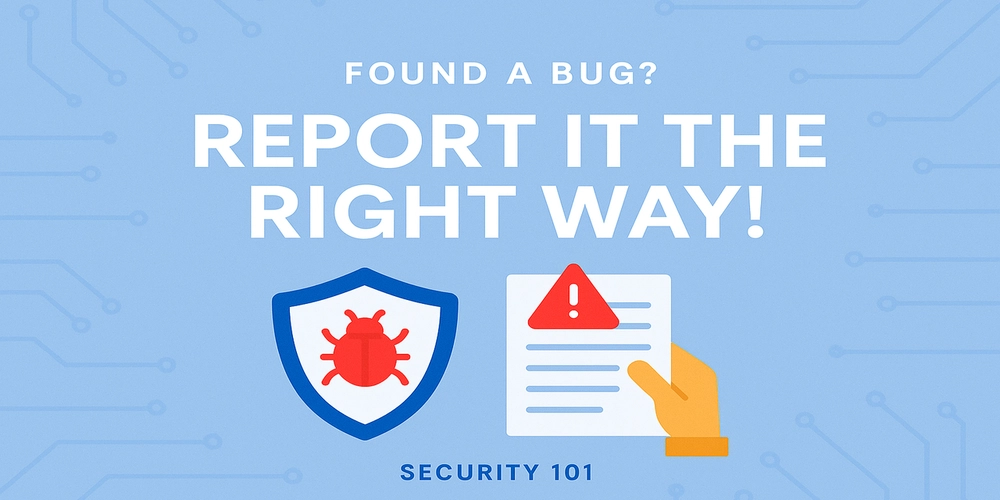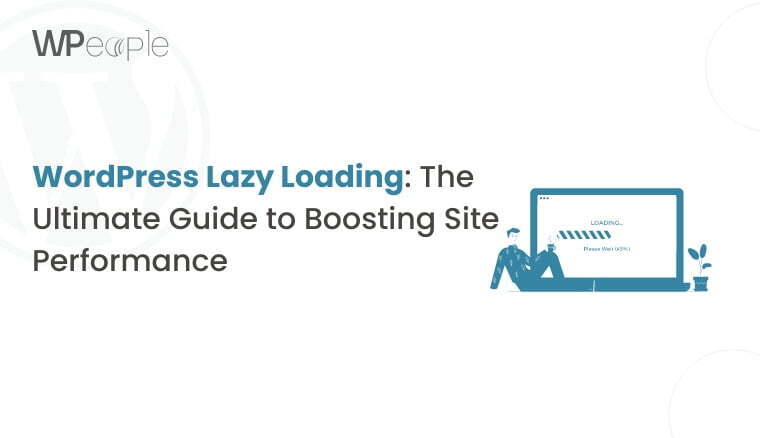How to Report a Security Vulnerability Responsibly
Let's say you find a gap in the fence of a secure building. You might just leave, or even worse, inform the wrong parties. But the ethical thing to do is inform the owners of the building so that they can repair it before someone gets harmed. Identifying a security vulnerability in a web site, an application, or a system functions similarly. Security researchers and even ordinary users happen to identify some weaknesses from time to time. Reporting responsibly maintains the security for all of us — the user community, organizations, and the general internet. We shall take you through reporting a vulnerability the proper way, why doing so is essential, and good practices to practice in this blog post. Prefer watching instead of reading? Here’s a quick video guide Why Responsible Disclosure Matters When you discover a vulnerability, you possess valuable information — but also a lot of responsibility. Here's why responsible disclosure is important: Saves users: A lot of users might be vulnerable if the problem isn't solved immediately. Aids organizations: Organizations usually value individuals who assist them in making security better. Earns trust: Being ethical demonstrates that you are professional and trustworthy. Save legal headaches: Misusing or disclosing a vulnerability in an irresponsible manner can get you into legal trouble. Think of it as being a good digital citizen. Confirm the Vulnerability Don't jump to report: Double-check: Ensure the vulnerability is not a misperception. At times what is perceived as a bug is in fact a feature or normal behavior. Document evidence: Take screenshots, videos, or logs of the problem. Good documentation will ensure the security team grasp and replicate the issue. Important: Avoid causing damage or accessing data you’re not supposed to. Always stay within legal and ethical boundaries. Gather Key Details Your report will be stronger if it includes specific, well-organized information: Description: Clearly explain what the vulnerability is. Impact: What could an attacker do by exploiting this issue? Steps to reproduce: Provide a simple, step-by-step guide so the security team can recreate the problem. Environment: Include information such as browser version, operating system, or app version. Proof of concept (PoC): If it's safe to do so, include sample code or actions showing the vulnerability. Act like a detective: the clearer your evidence, the quicker the fix. Use the Right Channel Most businesses have ways of reporting vulnerabilities: Security page: Check if there is a "Security" or "Responsible Disclosure" page on the business's website. Bug bounty programs: Sites such as HackerOne, Bugcrowd, or Synack coordinate vulnerability reporting for numerous firms. Security email: If you can't locate a program, email security@[companyname].com (this is the standard format). Contact form: Some sites have contact forms for general questions — you can send your first note there if necessary. Pro tip: If you're not sure, look at their privacy policy, terms of service, or try a search engine with keywords such as "[company name] vulnerability disclosure." Write a Clear and Professional Report When reporting to the organization: Be respectful: Be polite and professional in your wording. Be concise: Keep to the facts without extra information. Respect confidentiality: Only share your findings with the organization, not on social media or public forums. Here's a basic template you can use: Subject: [Security Vulnerability Report] [Brief Title of Issue] Dear [Company Name] Security Team, I found a security vulnerability on your site that I think might affect your users. Here are the details: Description: [Describe what the vulnerability is] Impact: [Describe what would happen if exploited] Steps to Reproduce: [Enumerate step-by-step] Environment: [e.g., Windows 11, Chrome Version 123.0] Proof of Concept: [Insert sample code or screenshots] If you require more information, please do not hesitate to inform me. I await your answer. You are appreciated for your time and effort in protecting users. Best regards, [Your Name] [Optional: LinkedIn/Twitter/Website] Let Them Have Time to React After you report the vulnerability: Be patient: Companies have internal procedures. It may take days or weeks before they can investigate. Wait for embargo times: Certain businesses may request you to hold off until the bug is resolved before announcing it in public. Follow up: Unless you get a response in a reasonable timeframe (e.g., 2-3 weeks), it's okay to send a friendly reminder. Note that their concern is typically keeping users safe, so most delays aren't personal. Approach Public Disclosure with Caution (If Any) In others, researchers can publish a write-up, a talk, or a blog post on the results. It will educate oth

Let's say you find a gap in the fence of a secure building. You might just leave, or even worse, inform the wrong parties. But the ethical thing to do is inform the owners of the building so that they can repair it before someone gets harmed.
Identifying a security vulnerability in a web site, an application, or a system functions similarly. Security researchers and even ordinary users happen to identify some weaknesses from time to time. Reporting responsibly maintains the security for all of us — the user community, organizations, and the general internet.
We shall take you through reporting a vulnerability the proper way, why doing so is essential, and good practices to practice in this blog post.
Prefer watching instead of reading? Here’s a quick video guide
Why Responsible Disclosure Matters
When you discover a vulnerability, you possess valuable information — but also a lot of responsibility. Here's why responsible disclosure is important:
- Saves users: A lot of users might be vulnerable if the problem isn't solved immediately.
- Aids organizations: Organizations usually value individuals who assist them in making security better.
- Earns trust: Being ethical demonstrates that you are professional and trustworthy.
- Save legal headaches: Misusing or disclosing a vulnerability in an irresponsible manner can get you into legal trouble.
Think of it as being a good digital citizen.
Confirm the Vulnerability
Don't jump to report:
- Double-check: Ensure the vulnerability is not a misperception. At times what is perceived as a bug is in fact a feature or normal behavior.
- Document evidence: Take screenshots, videos, or logs of the problem. Good documentation will ensure the security team grasp and replicate the issue.
Important: Avoid causing damage or accessing data you’re not supposed to. Always stay within legal and ethical boundaries.
Gather Key Details
Your report will be stronger if it includes specific, well-organized information:
- Description: Clearly explain what the vulnerability is.
- Impact: What could an attacker do by exploiting this issue?
- Steps to reproduce: Provide a simple, step-by-step guide so the security team can recreate the problem.
- Environment: Include information such as browser version, operating system, or app version.
- Proof of concept (PoC): If it's safe to do so, include sample code or actions showing the vulnerability.
Act like a detective: the clearer your evidence, the quicker the fix.
Use the Right Channel
Most businesses have ways of reporting vulnerabilities:
- Security page: Check if there is a "Security" or "Responsible Disclosure" page on the business's website.
- Bug bounty programs: Sites such as HackerOne, Bugcrowd, or Synack coordinate vulnerability reporting for numerous firms.
- Security email: If you can't locate a program, email security@[companyname].com (this is the standard format).
- Contact form: Some sites have contact forms for general questions — you can send your first note there if necessary.
Pro tip: If you're not sure, look at their privacy policy, terms of service, or try a search engine with keywords such as "[company name] vulnerability disclosure."
Write a Clear and Professional Report
When reporting to the organization:
- Be respectful: Be polite and professional in your wording.
- Be concise: Keep to the facts without extra information.
- Respect confidentiality: Only share your findings with the organization, not on social media or public forums.
Here's a basic template you can use:
Subject: [Security Vulnerability Report] [Brief Title of Issue]
Dear [Company Name] Security Team,
I found a security vulnerability on your site that I think might affect your users. Here are the details:
- Description: [Describe what the vulnerability is]
- Impact: [Describe what would happen if exploited]
- Steps to Reproduce: [Enumerate step-by-step]
- Environment: [e.g., Windows 11, Chrome Version 123.0]
- Proof of Concept: [Insert sample code or screenshots]
If you require more information, please do not hesitate to inform me. I await your answer.
You are appreciated for your time and effort in protecting users.
Best regards,
[Your Name]
[Optional: LinkedIn/Twitter/Website]
Let Them Have Time to React
After you report the vulnerability:
- Be patient: Companies have internal procedures. It may take days or weeks before they can investigate.
- Wait for embargo times: Certain businesses may request you to hold off until the bug is resolved before announcing it in public.
- Follow up: Unless you get a response in a reasonable timeframe (e.g., 2-3 weeks), it's okay to send a friendly reminder.
Note that their concern is typically keeping users safe, so most delays aren't personal.
Approach Public Disclosure with Caution (If Any)
In others, researchers can publish a write-up, a talk, or a blog post on the results. It will educate other people and display your capabilities.
Before you:
- Get permission: Ensure that the company is fine with you sharing information.
- Redact sensitive info: Remove any company secrets or personal user information.
- Education focus: Describe the type of vulnerability, prevention measures, and what was learned — not merely "hey, check out what I discovered."
Critical: In case the company just ignores you after multiple tries, and the vulnerability is seriously at risk, coordinated disclosure through recognized third parties (such as CERT or companies which act as go-betweens for researchers and firms) can be a consideration.
Bonus Tips for Responsible Reporting
- Remain anonymous if necessary: You can report anonymously or with a pseudonym if you wish.
- Look for legal safeguards: Some bug bounty programs provide safe harbor clauses to shield researchers.
- Be careful with monetary requests: Requesting a bounty can appear suspicious if not done properly. Only negotiate bounties if the company has an explicit bounty program.
And above all: always act in good faith.
Final Thoughts
Reporting security vulnerabilities responsibly is an important way to strengthen digital security for everyone. Whether you’re an experienced ethical hacker or someone who stumbled across an issue by accident, following a careful, professional approach ensures your discovery leads to positive change — not unintended harm.
Consider yourself an internet guardian. Being responsible not only safeguards others but also enhances your reputation as a person that makes the online world a safer place.


































































































































































![[The AI Show Episode 143]: ChatGPT Revenue Surge, New AGI Timelines, Amazon’s AI Agent, Claude for Education, Model Context Protocol & LLMs Pass the Turing Test](https://www.marketingaiinstitute.com/hubfs/ep%20143%20cover.png)






























































































































![[DEALS] Koofr Cloud Storage: Lifetime Subscription (1TB) (80% off) & Other Deals Up To 98% Off – Offers End Soon!](https://www.javacodegeeks.com/wp-content/uploads/2012/12/jcg-logo.jpg)






















![Is this too much for a modular monolith system? [closed]](https://i.sstatic.net/pYL1nsfg.png)



















































































































_roibu_Alamy.jpg?width=1280&auto=webp&quality=80&disable=upscale#)














































































































![M4 MacBook Air Drops to Just $849 - Act Fast! [Lowest Price Ever]](https://www.iclarified.com/images/news/97140/97140/97140-640.jpg)
![Apple Smart Glasses Not Close to Being Ready as Meta Targets 2025 [Gurman]](https://www.iclarified.com/images/news/97139/97139/97139-640.jpg)
![iPadOS 19 May Introduce Menu Bar, iOS 19 to Support External Displays [Rumor]](https://www.iclarified.com/images/news/97137/97137/97137-640.jpg)



































































































